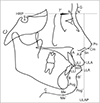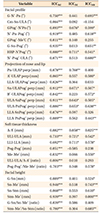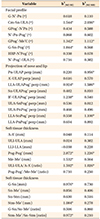1. Hunter WS. A study of the inheritance of craniofacial characteristics as seen in lateral cephalograms of 72 like-sexed twins. Rep Congr Eur Orthod Soc. 1965; 41:59–70.

2. Nakata N, Yu PI, Davis B, Nance WE. The use of genetic data in the prediction of craniofacial dimensions. Am J Orthod. 1973; 63:471–480.


3. Nakasima A, Ichinose M, Nakata S, Takahama Y. Hereditary factors in the craniofacial morphology of Angle's Class II and Class III malocclusions. Am J Orthod. 1982; 82:150–156.


4. Manfredi C, Martina R, Grossi GB, Giuliani M. Heritability of 39 orthodontic cephalometric parameters on MZ, DZ twins and MN-paired singletons. Am J Orthod Dentofacial Orthop. 1997; 111:44–51.


5. Savoye I, Loos R, Carels C, Derom C, Vlietinck R. A genetic study of anteroposterior and vertical facial proportions using model-fitting. Angle Orthod. 1998; 68:467–470.

6. Carels C, Van Cauwenberghe N, Savoye I, Willems G, Loos R, Derom C, et al. A quantitative genetic study of cephalometric variables in twins. Clin Orthod Res. 2001; 4:130–140.


7. Johannsdottir B, Thorarinsson F, Thordarson A, Magnusson TE. Heritability of craniofacial characteristics between parents and offspring estimated from lateral cephalograms. Am J Orthod Dentofacial Orthop. 2005; 127:200–207. quiz 260-1.


8. Amini F, Borzabadi-Farahani A. Heritability of dental and skeletal cephalometric variables in monozygous and dizygous Iranian twins. Orthod Waves. 2009; 68:72–79.

9. Ackerman JL, Proffit WR. Soft tissue limitations in orthodontics: treatment planning guidelines. Angle Orthod. 1997; 67:327–336.

10. Terajima M, Furuichi Y, Aoki Y, Goto TK, Tokumori K, Nakasima A. A 3-dimensional method for analyzing facial soft-tissue morphology of patients with jaw deformities. Am J Orthod Dentofacial Orthop. 2009; 135:715–722.


11. Vanco C, Kasai K, Sergi R, Richards LC, Townsend GC. Genetic and environmental influences on facial profile. Aust Dent J. 1995; 40:104–109.


12. Naini FB, Moss JP. Three-dimensional assessment of the relative contribution of genetics and environment to various facial parameters with the twin method. Am J Orthod Dentofacial Orthop. 2004; 126:655–665.


13. Baydaş B, Erdem A, Yavuz I, Ceylan I. Heritability of facial proportions and soft-tissue profile characteristics in Turkish Anatolian siblings. Am J Orthod Dentofacial Orthop. 2007; 131:504–509.


14. Sipahioğlu S, Ulubay H, Diren HB. Midline facial soft tissue thickness database of Turkish population: MRI study. Forensic Sci Int. 2012; 219:282.e1–282.e8.

17. Baillie LJ, Mirijali SA, Niven BE, Blyth P, Dias GJ. Ancestry and BMI influences on facial soft tissue depths for a cohort of Chinese and caucasoid women in Dunedin, New Zealand. J Forensic Sci. 2015; 60:1146–1154.


18. Thiemann N, Keil V, Roy U. In vivo facial soft tissue depths of a modern adult population from Germany. Int J Legal Med. 2017; 131:1455–1488.


19. Kim E, Sung J, Song YM, Chae HS, Mo SS, Kim YH, et al. Heritability of facial skeletal and dental characteristics of monozygotic and dizygotic twins using cephalometric analysis and Falconer's method. J Craniofac Surg. 2018; 29:e274–e279.

20. Shrout PE, Fleiss JL. Intraclass correlations: uses in assessing rater reliability. Psychol Bull. 1979; 86:420–428.


21. Falconer DS. Introduction to quantitative genetics. 1st ed. New Jersey: Prentice Hall Press;1975.
22. Šidlauskas M, Šalomskienė L, Andriuškevičiūtė I, Šidlauskienė M, Labanauskas Ž, Vasiliauskas A, et al. Heritability of mandibular cephalometric variables in twins with completed craniofacial growth. Eur J Orthod. 2016; 38:493–502.


23. Mayer C, Windhager S, Schaefer K, Mitteroecker P. BMI and WHR are reflected in female facial shape and texture: a geometric morphometric image analysis. PLoS One. 2017; 12:e0169336.

24. Tsagkrasoulis D, Hysi P, Spector T, Montana G. Heritability maps of human face morphology through large-scale automated three-dimensional phenotyping. Sci Rep. 2017; 7:45885.

25. Djordjevic J, Zhurov AI, Richmond S. Visigen Consortium. Genetic and environmental contributions to facial morphological variation: A 3D population-based twin study. PLoS One. 2016; 11:e0162250.

26. Macari AT, Hanna AE. Comparisons of soft tissue chin thickness in adult patients with various mandibular divergence patterns. Angle Orthod. 2014; 84:708–714.


27. Somaiah S, Khan MU, Muddaiah S, Shetty B, Reddy G, Siddegowda R. Comparison of soft tissue chin thickness in adult patients with various mandibular divergence patterns in Kodava population. Int J Orthod Rehabil. 2017; 8:51–56.

28. Kurkcuoglu A, Pelin C, Ozener B, Zagyapan R, Sahinoglu Z, Yazici AC. Facial soft tissue thickness in individuals with different occlusion patterns in adult Turkish subjects. Homo. 2011; 62:288–297.






 PDF
PDF ePub
ePub Citation
Citation Print
Print










 XML Download
XML Download